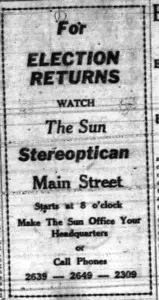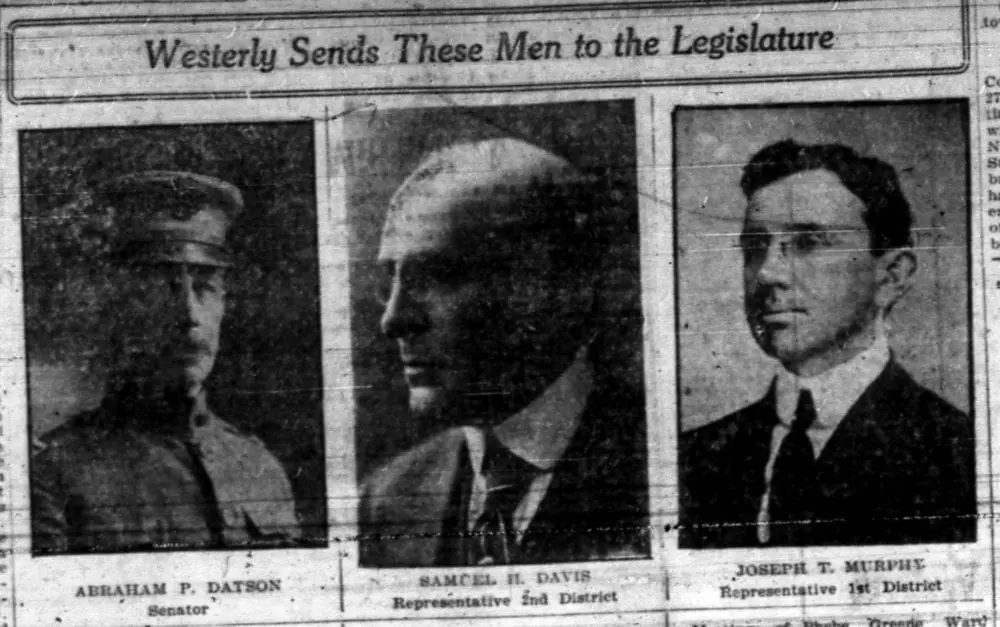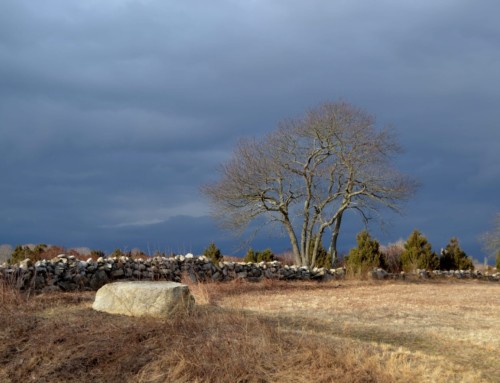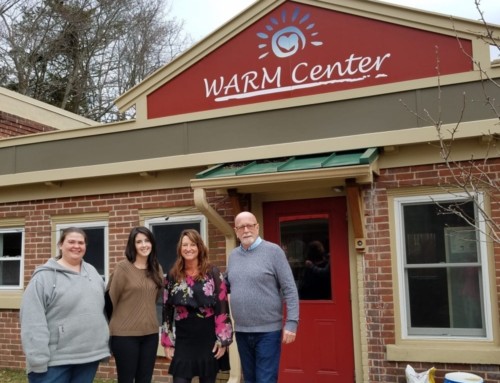As we approach the 2020 Presidential Election, we are also nearing the 100th anniversary of the 1920 election, a monumental moment in the history of our nation. For the first time, women were legally allowed to vote in a presidential election after the ratification of the Nineteenth Amendment to the United States Constitution on August 18, 1920. This election offers remarkable insight into the views of many Westerly voters at the start of the ‘Roaring Twenties.’
Nationally, the 1920 elections represented a shift in American politics, as the Republican Party’s candidate, Warren G. Harding, won handily after receiving 60.3% of the vote. Harding’s opponent, James M. Cox, received only 34.1% of the national vote.[1] This result signaled renewed support for the Republican Party after Woodrow Wilson, a Democrat, was elected to the presidency with ease in 1912 and was re-elected by a much smaller margin in 1916. [2] Between 1900 and 1932, a Republican won six of the eight presidential elections.
This Republican domination was quite apparent in Rhode Island, where Harding’s 107,463 votes were more than twice the 55,062 received by Cox. [3] To date, this is the final election in which a Republican received more than 60% of the vote in Rhode Island. This information becomes clearer upon a closer look at the days leading up to the election, as well as the results in Westerly.

Those who hoped to vote in the elections on November 2 were required to pay the Westerly Poll Tax (a practice that was not abolished until the passing of the 24th Amendment in 1964) of one dollar by October 30 if they wished to vote. Aside from precluding a citizen from voting, failure to pay the poll tax could also result in jail time according to Rhode Island law, a portion of which was published in the Sun. [5]
Women were not required to pay the Poll Tax for 1920. In order to aid citizens in ensuring they were prepared to vote, on October 26 the Westerly Town Council met and served as a board of canvassers, allowing men and women to come in and register to vote. This was promoted as the final opportunity for eligible citizens to register as they were required to be added to the voting list prior to Election Day.[6] The Westerly Sun implored citizens “It is the duty of every would be voter to make certain that his or her name is on the voting list.”[7]

That same day, just six days prior to the election, a “rally of all voters of the town of Westerly” was held at the town hall. [9] Although the announcement of this event specifically mentions that it is for “all voters,” it was quite clear that this referred to those who intended to vote for Republicans. This was made abundantly clear by the statement that “Republican issues will be discussed” and attendees would be able to “hear the Republican side of the story.”[10] It is also mentioned that women were invited to attend and it was hoped that they would “turn out in large numbers.”[11]
At this rally, the Democratic opponent of Stiness, Luigi De Pasquale, was roundly criticized for supposedly using his position as a member of the Rhode Island General Assembly to avoid being drafted in World War I despite being a single man and only 25 years old.[12] Italian-American men from Westerly who died in the war were referenced by name as a means of further admonishing what the opposition perceived to be De Pasquale’s decision. [13]
Three days later on October 30, Democratic candidates and supporters held a rally of their own. However, the sentiment towards the Democratic Party in Westerly was readily apparent from the tone of the announcement which began “Democratic spellbinders are to waste their time by holding a rally in republican Westerly…”[14]
The time and location of this rally were never provided. Two nights later on the eve of the election, a meeting for women was held at the Westerly High School Hall to show the first-time voters how to complete the ballot properly and to answer any questions that they may have had.[15] In the days leading up to the election, the campaigning by the Republican Party continued, with advertisements claiming that voting the straight Republican ticket was “the First Duty of Every Red-Blooded American.” [16] The sponsor of these advertisements was listed simply as “a Westerly Citizen Who Believes in Republican Principles.”[17]
On November 2, 1920, Americans made their way to their local polling places and cast their ballots. The first person to place their vote in Westerly was Anna Thornton Williams (more about Mrs. Williams can be read here).[18] For the first time in history, the election results were conveyed to the Westerly Sun by telephone.
The Sun served as the pre-eminent source for voting returns across the town, as they installed a stereopticon across the street from their offices to broadcast the results and also offered their facilities as a base for those interested in following the local and national races.[19] The Colonial Club of Westerly also presented real-time results, as they ran telegraph wires from the Westerly Library to the Post Office where the club was headquartered.[20]
As was expected, Westerly residents overwhelmingly chose Warren G. Harding as their selection to be the next United States President. The combination of Harding and Calvin Coolidge received 2,070 votes in Westerly to 490 votes for James M. Cox and his running mate, Franklin Delano Roosevelt.[21] Westerly’s proportion of voters supporting Harding (78.63%) was much larger than the State of Rhode Island as a whole (63.97%).[22]
Four other candidates received at least one vote in Westerly, including Robert Colvin Macauley of the Single Tax Party who received a single vote in town and only 5,750 nationally.[23] Harding was not the only Republican to win big in Westerly. Walter R. Stiness crushed Luigi De Pasquale 1930 to 646 and Emery J. San Souci, the Republican candidate for Governor of Rhode Island vanquished his opponent, Edward M. Sullivan, by a tally of 2045 to 510.[24]
In addition to contributing significantly to the overall Republican victory, Westerly also sent three local men to the Rhode Island Legislature: Senator Abraham P. Datson and Representatives Samuel H. Davis and Joseph T. Murphy.[25] All three of these men were members of the Republican Party and received an overwhelming share of the votes coming out of Westerly.[26]
After serving less than three years of his term, Warren G. Harding died in office and was succeeded by his Vice President, Calvin Coolidge. It is likely that Westerly voters approved of the work done by the men they supported so fervently in 1920, as they voted to re-elect Coolidge by a margin of more than 42% in 1924.[27] Although the 1920 presidential election in Westerly was not a particularly close or contentious race, it remains a significant historical landmark both locally and in America as a whole.
[su_accordion class=””] [su_spoiler title=”Footnotes” open=”no” style=”default” icon=”plus” anchor=”” class=””]
- Counting The Votes, Election of 1920, http://www.countingthevotes.com/1920/.
- Counting The Votes, Election of 1912, http://www.countingthevotes.com/1912/ and Counting The Votes, Election of 1916, http://www.countingthevotes.com/1916/.
- 1920 Presidential General Election Results – Rhode Island, https://uselectionatlas.org/RESULTS/state.php?year=1920&fips=44&f=1&off=0&elect=0.
- “Proclamation That Suffrage Has Been Ratified Is Signed by Secretary Colby” Westerly Sun, 26 August 1920.
- “Poll Tax for the Year of 1920” Westerly Sun, 25 October 1920.
- “Things Voters Ought to Know” Westerly Sun, 26 October 1920.
- “Council to Canvas the Voting List” Westerly Sun, 26 October 1920.
- “Republican Candidate for Congress” Westerly Sun, 27 October 1920.
- “Westerly Voters to Hear Issues” Westerly Sun, 25 October 1920.
- “Westerly Voters to Hear Issues” Westerly Sun, 25 October 1920.
- “Westerly Voters to Hear Issues” Westerly Sun, 25 October 1920.
- “Sweeping Republican Victory Is Predicted at Rally Here” Westerly Sun, 28 October 1920.
- “Sweeping Republican Victory Is Predicted at Rally Here” Westerly Sun, 28 October 1920.
- “Westerly” Norwich Bulletin, 30 October 1920.
- “Westerly Women to See Ballot” Westerly Sun, 31 October 1920.
- Advertisement, Westerly Sun, 31 October 1920.
- Advertisement, Westerly Sun, 31 October 1920.
- “Former Slave First to Vote” Westerly Sun, 2 November 1920.
- “Sun Plans for Election Results” Westerly Sun, 1 November 1920.
- “Election Results by Radio Telephone” Westerly Sun, 2 November 1920.
- “Westerly Strong for Harding” Westerly Sun, 3 November 1920.
- 1920 Presidential General Election Results – Rhode Island, https://uselectionatlas.org/RESULTS/state.php?year=1920&fips=44&f=1&off=0&elect=0
- 1920 Presidential General Election Results, https://uselectionatlas.org/RESULTS/national.php?year=1920&minper=0&f=0&off=0&elect=0.
- “Westerly Leads State in Ratios” Westerly Sun, 3 November 1920.
- “Westerly Sends These Men to the Legislature” Westerly Sun, 3 November 1920.
- “Westerly Leads State in Ratios” Westerly Sun, 3 November 1920.
- 1924 Presidential General Election Results – Rhode Island, https://uselectionatlas.org/RESULTS/state.php?year=1924&fips=44&f=0&off=0&elect=0&minper=0.
[/su_spoiler] [/su_accordion]






